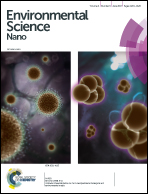Co-exposure of C60 fullerene with benzo[a]pyrene results in enhanced biological effects in cells as determined by Fourier-transform infrared spectroscopy†
Abstract
C60 fullerene (C60) is a promising manufactured carbon-based nanoparticle (NP). With an increasing number of applications, it is being found in the environment. In addition, C60 is likely to associate with other environmental toxic contaminants. How such interactions with C60 can impact on the environmental fate, transport and bioavailability of toxicants remains unknown. Benzo[a]pyrene (B[a]P) is a polycyclic aromatic hydrocarbon (PAH). Herein, two cell lines (fish gill or MCF-7 cells) were employed to explore the biological impacts of co-exposure to C60 and B[a]P. Post-exposure cells were analyzed using Fourier-transform infrared (FTIR) microspectroscopy. By inputting spectral data into principal component analysis and linear discriminant analysis, data reduction allowed for visualisation of cell categorization and identification of wavenumber-related biomarkers corresponding to cellular alterations. Our results indicate that low-dose C60 increases B[a]P-induced alterations, while C60 at high concentrations reduces these effects. We also found that although C60 co-exposure increases B[a]P-induced CYP1A1 induction, co-exposure seemingly attenuates the levels of oxidative damage induced by either agent singly. This suggests that interactions between environmental NPs and contaminants are complex and unpredictable.
![Graphical abstract: Co-exposure of C60 fullerene with benzo[a]pyrene results in enhanced biological effects in cells as determined by Fourier-transform infrared spectroscopy](/en/Image/Get?imageInfo.ImageType=GA&imageInfo.ImageIdentifier.ManuscriptID=C7EN00164A&imageInfo.ImageIdentifier.Year=2017)


 Please wait while we load your content...
Please wait while we load your content...